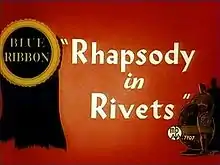Rhapsody in Rivets
Rhapsody in Rivets is a 1941 Warner Bros. Merrie Melodies cartoon directed by Friz Freleng.[1] The short was released on December 6, 1941.[2]
| Rhapsody in Rivets | |
|---|---|
 Blur Ribbon reissue title card | |
| Directed by | I. Freleng |
| Produced by | Leon Schlesinger |
| Story by | Michael Maltese |
| Music by | Carl Stalling |
| Animation by | Gil Turner |
| Color process | Technicolor |
Production company | |
| Distributed by | Warner Bros. Pictures The Vitaphone Corporation |
Release date | December 6, 1941 |
Running time | 8 min. (one reel) |
| Country | United States |
| Language | English |
Plot
At a busy urban construction site in a world of anthropomorphic animals, an appreciative crowd of gawkers watches the foreman (a caricature of the conductor Leopold Stokowski) use the building plans as his score and conduct the workmen in Franz Liszt's "Hungarian Rhapsody No. 2", a symphony of riveting, hammering, sawing, and more. Elevators, picks, shovels, and a steam shovel are instruments in music making and construction.
As the clock nears 5:00 PM, the crew works furiously, and the building rises around the clouds. With a flag planted at the top and the work completed, the foreman takes a bow. One of the workers, while leaving, slams the door shut behind him; due to this and the overly hurried construction, the building (labeled the "Umpire State") comes crashing down. The foreman attempts to attack the worker in retaliation, but three bricks hit him on the head for the last three notes, ending the rhapsody and the cartoon.
Reception
Daniel Goldmark writes, "While almost every studio in Hollywood took on Liszt's "Second Hungarian Symphony" at one time or another, Warner Bros. did it twice — both times with Friz Freleng directing. (Rhapsody Rabbit, 1946, was the other.) What sets this version apart from all the others is that, while it keeps the spirit of a concert or performance, the execution is different. Freleng's central metaphor — comparing the skills and coordination of a construction crew to those of an orchestra — works remarkably well, giving a new twist to what had already become a cliché by then, a well-known classical work being played (or murdered) by a motley group of musicians. And because the "Rhapsody" was also a classical standard, bordering on a pop hit, Freleng could easily use just the best-known parts of the work to drive the several dozen gags."[3]
Availability
- LaserDisc - The Golden Age of Looney Tunes, Vol. 1, Side 6: Friz Freleng
- VHS - The Golden Age of Looney Tunes, Vol. 6: Friz Freleng
- (1999) VHS - Looney Tunes: The Collectors Edition Volume 5: Musical Masterpieces (1995 Turner dubbed version)
- (2007) DVD -The Bride Came C.O.D. (1995 Turner dubbed version, added as a bonus)
- DVD - Warner Bros. Home Entertainment Academy Awards Animation Collection, Disc 2
- Blu-Ray, DVD - Looney Tunes Platinum Collection: Volume 3, Disc 2
- (2015) DVD - Looney Tunes Musical Masterpieces
Notes
- Rhapsody in Rivets is the first Warner Bros. cartoon to feature the "Hungarian Rhapsody No. 2" by Franz Liszt.
- The short has no dialogue.
- The cartoon was nominated for the Academy Award for Best Animated Short Film in 1942 alongside another Warner Bros. cartoon directed by Freleng, "Hiawatha's Rabbit Hunt". Both lost to Walt Disney's "Lend a Paw".
- This short was one of two that originally credited Schlesinger that was reissued in the 1954-55 season, the other being "The Trial of Mr. Wolf".
- It was reissued two times; once in 1947 (evident of the closing card) and again in 1955.
- Though this short has no dialogue, the Blue Ribbon ending card is still replaced by the 1947-48 Turner "dubbed" card in the 1995 American and European Turner prints. What is more, the European Turner print opening has red borders, while the American Turner prints has none.
References
- Beck, Jerry; Friedwald, Will (1989). Looney Tunes and Merrie Melodies: A Complete Illustrated Guide to the Warner Bros. Cartoons. Henry Holt and Co. p. 173. ISBN 0-8050-0894-2.
- Lenburg, Jeff (1999). The Encyclopedia of Animated Cartoons. Checkmark Books. pp. 104–106. ISBN 0-8160-3831-7. Retrieved 6 June 2020.
- Beck, Jerry, ed. (2020). The 100 Greatest Looney Tunes Cartoons. Insight Editions. p. 154. ISBN 978-1-64722-137-9.